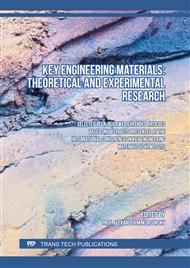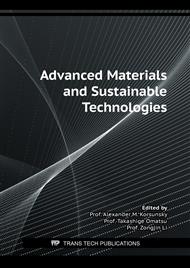[1]
S. Sagbas and N. Sahiner, 22 - Carbon dots: preparation, properties, and application,, in Nanocarbon and its Composites, A. Khan, M. Jawaid, Inamuddin, and A. M. Asiri, Eds. Woodhead Publishing, 2019, p.651–676.
DOI: 10.1016/b978-0-08-102509-3.00022-5
Google Scholar
[2]
Wang, Youfu & Hu, Aiguo. (2014). Carbon quantum dots: Synthesis, properties and applications. J. Mater. Chem. C. 2. 10.1039/C4TC00988F.
Google Scholar
[3]
M Ghali, M Elnimr, Gh F Ali, B Yousif, Colloidal CuInSe2 nanocrystals and thin films for low-cost photovoltaics, Optical Mmaterials, vol.55, pp.145-152,2016, doi.org/10.1016/j.optmat. 2016.03.026?.
DOI: 10.1016/j.optmat.2016.03.026
Google Scholar
[4]
B. S. B. Kasibabu, S. L. D'souza, S. Jha, R. K. Singhal, H. Basu, and S. K. Kailasa, One-step synthesis of fluorescent carbon dots for imaging bacterial and fungal cells,, Anal. Methods, vol. 7, no. 6, p.2373–2378, 2015,.
DOI: 10.1039/c4ay02737j
Google Scholar
[5]
Y. Bakier, M. Ghali, A. Elkun, A. Beltagi, W. Zahra, Static interaction between colloidal carbon nano-dots and aniline: A novel platform for ultrasensitive detection of aniline in aqueous media, Materials Research Bulletin,, Vol. 134, pp-111119-2021, 111119, https://doi.org/10.1016/j.materresbull.(2020).
DOI: 10.1016/j.materresbull.2020.111119
Google Scholar
[6]
W. A. Qureshi, B. Vivekanandan, J. A. Jayaprasath, D. Ali, S. Alarifi, and K. Deshmukh, Antimicrobial Activity and Characterization of Pomegranate Peel-Based Carbon Dots,, vol. 2021, (2021).
DOI: 10.1155/2021/9096838
Google Scholar
[7]
Optical sensing of pyridine based on green synthesis of passivated carbon dots, HM Ahmed, M Ghali, WK Zahra, M Ayad, Materials Today: Proceedings 33, 1845-1848, 2020, https://doi.org/10.1016/j.matpr.2020.05.185.
DOI: 10.1016/j.matpr.2020.05.185
Google Scholar
[8]
I. A. Adelere and A. Lateef, A novel approach to the green synthesis of metallic nanoparticles : the use of agro-wastes , enzymes , and pigments,, vol. 5, no. 6, p.567–587, 2016,.
DOI: 10.1515/ntrev-2016-0024
Google Scholar
[9]
J. A. Guerrero-solano, O. A. Jaramillo-morales, C. Vel, M. De O-arciniega, and A. Castañeda-ovando, Pomegranate as a Potential Alternative of Pain Management : A Review," p.1–18.,.
DOI: 10.3390/plants9040419
Google Scholar
[10]
M. H. Jang, X. L. Piao, J. M. Kim, S. W. Kwon, and J. H. Park, Inhibition of cholinesterase and amyloid-&bgr; aggregation by resveratrol oligomers from Vitis amurensis,, Phyther. Res., vol. 22, no. 4, p.544–549, 2008,.
DOI: 10.1002/ptr.2406
Google Scholar
[11]
F. Akhgari, K. Farhadi, N. Samadi, and M. Akhgari, Detection of Silver Nanoparticles Using Green Synthesis of Fluorescent Nitrogen-Doped Carbon Dots,, Iran. J. Sci. Technol. Trans. A Sci., vol. 44, no. 2, p.379–387, 2020,.
DOI: 10.1007/s40995-020-00832-4
Google Scholar
[12]
K. Ko, Y. Dadmohammadi, and A. Abbaspourrad, Nutritional and bioactive components of pomegranate waste used in food and cosmetic applications: A review,, Foods, vol. 10, no. 3, 2021,.
DOI: 10.3390/foods10030657
Google Scholar
[13]
D. Terdal, Nutritional composition of fresh pomegranate peel powder,, ~ 692 ~ Int. J. Chem. Stud., vol. 6, no. 4, p.692–696, (2018).
Google Scholar
[14]
H. Muktha, R. Sharath, N. Kottam, S. P. Smrithi, K. Samrat, and P. Ankitha, Green Synthesis of Carbon Dots and Evaluation of Its Pharmacological Activities,, Bionanoscience, vol. 10, no. 3, p.731–744, 2020,.
DOI: 10.1007/s12668-020-00741-1
Google Scholar
[15]
H. Asadollahzadeh, M. Ghazizadeh, and M. Manzari, Developing a magnetic nanocomposite adsorbent based on carbon quantum dots prepared from Pomegranate peel for the removal of Pb(II) and Cd(II) ions from aqueous solution,, Anal. Methods Environ. Chem. J., vol. 4, no. 03, p.33–46, 2021,.
DOI: 10.24200/amecj.v4.i03.149
Google Scholar
[16]
Y. Vyas, P. Chundawat, Dharmendra, P. B. Punjabi, and C. Ameta, Green and Facile Synthesis of Luminescent CQDs from Pomegranate Peels and its Utilization in the Degradation of Azure B and Amido Black 10B by Decorating it on CuO Nanorods,, ChemistrySelect, vol. 6, no. 33, p.8566–8580, 2021,.
DOI: 10.1002/slct.202102156
Google Scholar
[17]
H. Mousavi, S. M. T. Ghomshe, A. Rashidi, and M. Mirzaei, Hybrids carbon quantum dots as new nanofluids for heat transfer enhancement in wet cooling towers,, Heat Mass Transf. und Stoffuebertragung, vol. 58, no. 2, p.309–320, 2022,.
DOI: 10.1007/s00231-021-03077-y
Google Scholar



